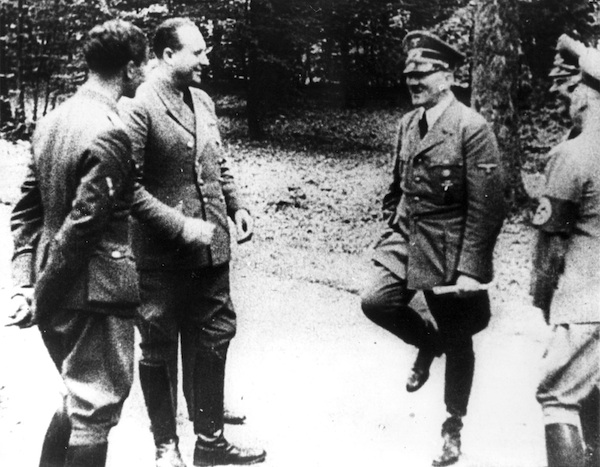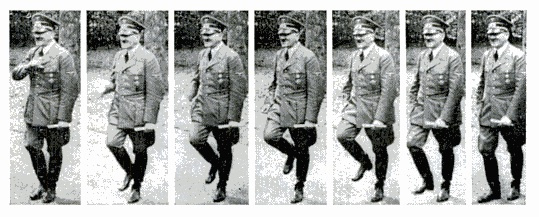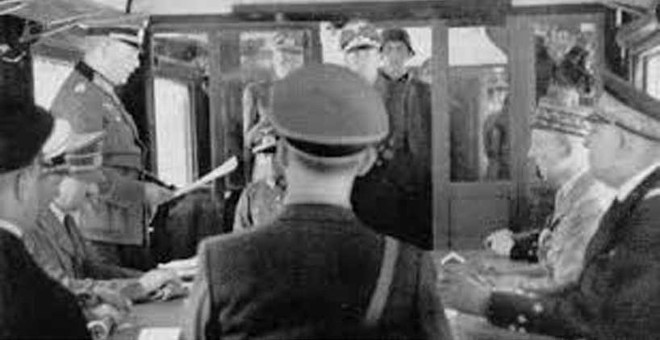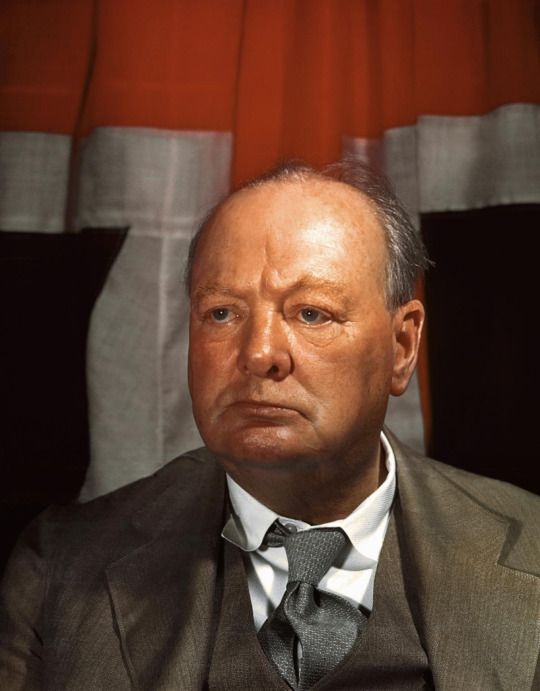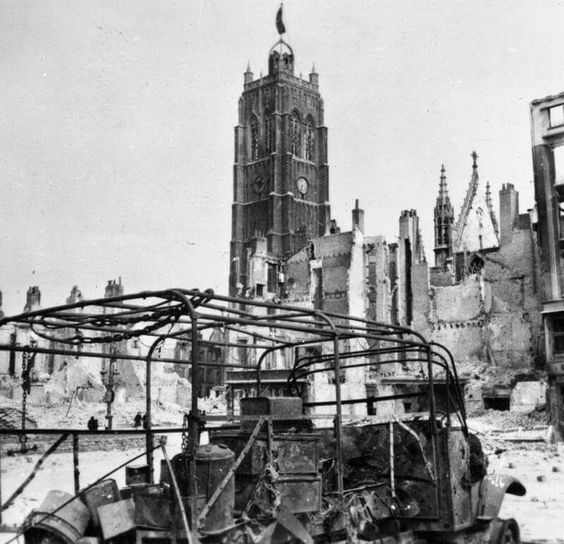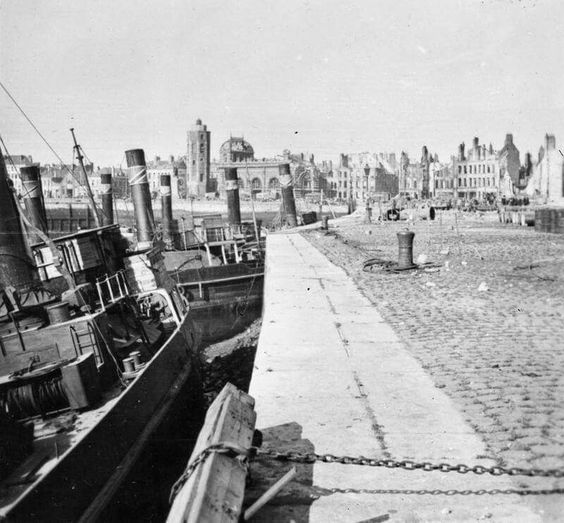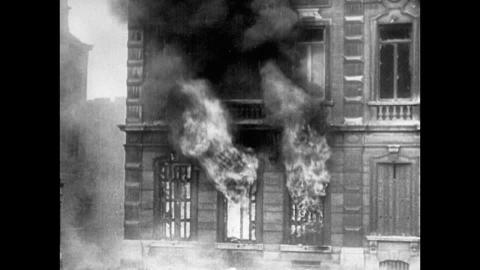Sunday 30 June 1940
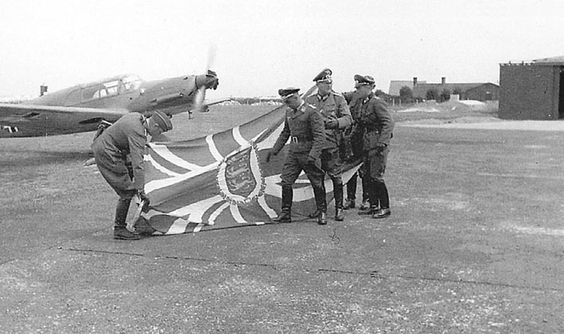 |
| Luftwaffe Officers on Guernsey handling the Union Jack with the Guernsey Crest, presumably folding it to replace with the Swastika flag, 30 June 1940. |
Western Front: As of 30 June 1940, there have been 220,000 French soldiers sealed in their Maginot Line fortresses since the Armistice of June 22. They have not posed a threat, but the Wehrmacht has not been able to enter their entire zone of occupation. Today, the French holdouts bow to the inevitable and finally surrender after a direct order from Commander-in-Chief Weygand.
A Franco-German-Italian Armistice Commission meets at Wiesbaden. The French delegation is led by General Huntziger. Numerous captured Wehrmacht troops, including some (later) famous names. Oberst (Colonel) Josef Kammhuber of KG51 and Werner Mölders return from POW camps to their old units or new postings. Kammhuber becomes an Officer with Special Duties of the RLM and Commander-in-Chief Luftwaffe, which basically means that he helps to establish new Luftwaffe doctrines and strategies.
The Heer has two combat battalions waiting at their boats ready to invade the Channel Islands despite British announcements that they are demilitarized and "open towns." To test the waters, a Luftwaffe pilot, Hauptmann Liebe-Pieteritz of Luftflotte 3, lands at Guernsey aerodrome - outfitted with white flags as specified in leaflets dropped by the Luftwaffe - and finds it deserted. Based on his report, the Luftflotte quickly flies in a platoon of troops in a Junkers Ju 52 transport to the same place. They meet no resistance.
In a genteel moment of international diplomacy, Inspector Sculpher of the Guernsey police force drives down to greet the German soldiers at the aerodrome. He is carrying a letter in German:
Battle of the Atlantic: Allied Shipping Losses for June:
U-65 and U-43 engage in embryonic "wolfpack" tactics against Convoy SL-25, beginning around 22:30.
U-43 (Kapitänleutnant Wilhelm Ambrosius) torpedoes and sinks British liner Avelona Star (after taking a day to sink). There are 84 survivors and one crewman perishes.
U-65 (Kapitänleutnant Hans-Gerrit von Stockhausen) torpedoes and damages British freighter Clan Ogilvy, which is taken in tow.
U-47 (Kapitänleutnant Günther Prien) sinks 4,201 ton Greek freighter Georgios Kyriakides west of Ireland. There are 30 crewmen who all survive.
U-26 (Kptl. Heinz Scheringer) sinks two ships about 250 miles southwest of Land's End. Its first victim is 1,291-ton Estonian freighter Merkur. Four crewmen perish.
U-26 then sinks 3,214-ton Norwegian freighter Belmoira. All 25 crewmen survive.
Battle of the Mediterranean: Air raids continue throughout the day, with the first by four SM-79 Italian bombers at around 10:00. Malta notches its 50th raid since the war began.
The RAF Swordfish based at Malta bomb oil installations at Augusta, Sicily.
Malta imposes a curfew of midnight on private cars.
Battle of the Pacific: German raider Orion (Kapitan zur See Kurt Weyher) is operating off Auckland. It sends captured Norwegian ship Tropic Sea to France loaded with prisoners. Captain Weyher renames the Norwegian ship the "Kurmark," which is Orion's name from before it joined the Kriegsmarine.
European Air Operations: The first daylight Luftwaffe raid on England occurs on East Hull when a single bomber sets a Saltend oil depot tank ablaze. The fires are put out quickly. The Heinkel 11 is later (17:00) shot down by RAF No. 616 Squadron and the crew rescued by a British destroyer.
The Luftwaffe attempts a raid for a second night in a row on the Bristol docks and nearby factories. For one reason or another, five of the six bombers abort the mission, but one Heinkel He 111 of III/KG55 makes it through to bomb the Bristol Aeroplane Company at Filton.
The Luftwaffe lays mines off Whitby. One of the Heinkel 111s has to ditch, and the crew is later rescued by the British after a full day adrift.
The RAF sends a raid against Merville and loses 3 of 9 Blenheims from RAF No. 107 Squadron. It also attacks Vignacourt, north of Abbeville. Targets in western Germany include oil storage tanks at Hamburg and an aerodrome at Norderney.
The fighters assigned to the Kriegsmarine aircraft carrier Graf Zeppelin, Tragergruppe 186, are re-assigned to JG 77 in defense of Berlin.
Battle of Britain: Luftwaffe boss Hermann Goering prepares the Luftwaffe for the upcoming Battle of Britain, stating that the mission is:
North Africa: The Regia Aeronautica bombs the 1st King's African Rifles unit at Moyale, Kenya.
War Crimes: The RAF shoots down a Heinkel He 59 which is clearly marked with white-painted, Red Cross emblems. The aircraft is engaged in a search and rescue mission and is not a legitimate target. This incident causes the Luftwaffe to camouflage and arm their search and rescue planes.
German Military: The Wehrmacht has been unstoppable to date, and everyone believes that the fall of Great Britain is now only a matter of (very little) time. However, Major General Alfred Jodl of the OKW proposes two alternative modes of attack:
US Navy: The US Navy continues its "show the flag" operation in Latin America. Heavy cruiser USS Wichita arrives at Montevideo, Uruguay, joining cruiser USS Quincy. The intention is to combat growing pro-German sentiment in certain circles there.
An inventory taken on this day, halfway through 1940, shows that the US Navy has 1,099 ships, with 160,997 in the Navy, 38,364 in the Marine Corps, and 13,766 in the Coast Guard, for a total of 203,127.
Prisoners of War: The SS Arandora Star departs from Great Britain for Canada carrying 1200 German and Italian POWs. Many of them are simply civilians being interned.
China: At the Battle of South Kwangsi, the Japanese 22nd Army approaches Lungchin.
The British evacuate their women and children from Hong Kong.
Holocaust: Himmler suggests removing the entire existing Polish population - to where or how is not decided - and replacing it with German "settlers."
Polish Homefront: The Polish Government-in-exile places General Rowecki in command of the Polish underground.
French Homefront: The Chantiers de Jeunesse, a quasi-military youth organization somewhat reminiscent of the Hitler Youth, is formed.
German Homefront: Listening to the BBC is strictly forbidden anywhere in Germany or occupied Europe. Today, five such "radio criminals" are sentenced to five years in concentration camps. However, the BBC is widely viewed as more factual than the German propaganda broadcasts, so almost everyone tunes in at least occasionally.
June 1940
June 1, 1940: Devastation at Dunkirk
June 2, 1940: Hitler Visits France
June 3, 1940: Operation Paula
June 4, 1940: We Shall Fight
June 5, 1940: Fall Rot
June 6, 1940: Weygand Line Crumbling
June 7, 1940: British Evacuating Narvik
June 8, 1940: Operation Juno
June 9, 1940: Norway Capitulates
June 10, 1940: Mussolini Throws Down
June 11, 1940: Paris an Open City
June 12, 1940: Rommel at St. Valery
June 13, 1940: France Goes Alone
June 14, 1940: Paris Falls
June 15, 1940: Soviets Scoop Up Lithuania
June 16, 1940: Enter Pétain
June 17, 1940: The Lancastria Sinks
June 18, 1940: A Day of Leaders
June 19, 1940: U-boats Run Wild
June 20, 1940: Pétain Wilts
June 21, 1940: Hitler's Happiest Day
June 22, 1940: France Is Done
June 23, 1940: Hitler in Paris
June 24, 1940: Six Million Jews
June 25, 1940: German Celebrations
June 26, 1940: USSR Being Belligerent
June 27, 1940: Malta in Peril
June 28, 1940: Channel Islands Bombed
June 29, 1940: Gandhi Insists on Independence
June 30, 1940: Channel Islands Occupied
July 1940
July 1, 1940: Vichy France
July 2, 1940: Arandora Star
July 3, 1940: Operation Catapult at Mers El Kébir
July 4, 1940: Romania In Crisis
July 5, 1940: The Five Freedoms
July 6, 1940: Hitler's High Point
July 7 1940: Dakar And Ringo
July 8, 1940: Tea Rationing in England
July 9, 1940: Battle of Calabria
July 10, 1940: Battle of Britain Begins
July 11, 1940: "Nous, Philippe Petain"
July 12, 1940: Enter Laval
July 13, 1940: German Surface Raiders Attack!
July 14, 1940: Bastille/Mourning Day
July 15, 1940: Tallest Man Dies
July 16, 1940: Plans for Sea Lion
July 17, 1940: Burma Road Closed
July 18, 1940: FDR Runs Again
July 19, 1940: Last Appeal To Reason
July 20, 1940: First Night Fighter Victory
July 21, 1940: Soviets Absorb Baltic States
July 22, 1940: First RAF Night Fighter Victory
July 23, 1940: Invasion False Alarm
July 24, 1940: The Meknés Incident
July 25, 1940: Black Thursday for RAF
July 26, 1940: Capture The Duke?
July 27, 1940: What's Up, Doc?
July 28, 1940: Destroyers Pulled From Dover
July 29, 1940: Barbarossa On The Burner
July 30, 1940: Hitler Delays Sealion
July 31, 1940: Bloody Wednesday of Olkusz
2020
A Franco-German-Italian Armistice Commission meets at Wiesbaden. The French delegation is led by General Huntziger. Numerous captured Wehrmacht troops, including some (later) famous names. Oberst (Colonel) Josef Kammhuber of KG51 and Werner Mölders return from POW camps to their old units or new postings. Kammhuber becomes an Officer with Special Duties of the RLM and Commander-in-Chief Luftwaffe, which basically means that he helps to establish new Luftwaffe doctrines and strategies.
The Heer has two combat battalions waiting at their boats ready to invade the Channel Islands despite British announcements that they are demilitarized and "open towns." To test the waters, a Luftwaffe pilot, Hauptmann Liebe-Pieteritz of Luftflotte 3, lands at Guernsey aerodrome - outfitted with white flags as specified in leaflets dropped by the Luftwaffe - and finds it deserted. Based on his report, the Luftflotte quickly flies in a platoon of troops in a Junkers Ju 52 transport to the same place. They meet no resistance.
In a genteel moment of international diplomacy, Inspector Sculpher of the Guernsey police force drives down to greet the German soldiers at the aerodrome. He is carrying a letter in German:
This Island has been declared an Open Island by His Majesty's Government of the United Kingdom. There are no armed forces of any description. The bearer has been instructed to hand this communication to you. He does not understand the German language.Wehrmacht commanding officer Major Albrecht Lanz accepts the surrender and then proceeds to the best hotel, the Royal Hotel, where he and his successors will set up their headquarters. Lanz meets the top (remaining) officials on the island. Everyone agrees that the Germans now are in control and that nobody is going to resist. They then all go out for lobster dinner after Lanz radios the waiting invasion troops and tells them he has handled everything. One can be quite sure that Hermann Goering has quite a laugh out of one-upping the army like this. This is a British territory, now occupied by German troops, the first such instance in the war.
 |
| The Castle Guard, formed from members of the training battalion, Grenadier Guards, leaving the main entrance of Windsor Castle on the way to Victoria Barracks in Windsor, 30 June 1940. |
- Atlantic: 130 ships of 505,453 tons
- Elsewhere: 10 ships of 268,075 tons
U-65 and U-43 engage in embryonic "wolfpack" tactics against Convoy SL-25, beginning around 22:30.
U-43 (Kapitänleutnant Wilhelm Ambrosius) torpedoes and sinks British liner Avelona Star (after taking a day to sink). There are 84 survivors and one crewman perishes.
U-65 (Kapitänleutnant Hans-Gerrit von Stockhausen) torpedoes and damages British freighter Clan Ogilvy, which is taken in tow.
U-47 (Kapitänleutnant Günther Prien) sinks 4,201 ton Greek freighter Georgios Kyriakides west of Ireland. There are 30 crewmen who all survive.
U-26 (Kptl. Heinz Scheringer) sinks two ships about 250 miles southwest of Land's End. Its first victim is 1,291-ton Estonian freighter Merkur. Four crewmen perish.
U-26 then sinks 3,214-ton Norwegian freighter Belmoira. All 25 crewmen survive.
Battle of the Mediterranean: Air raids continue throughout the day, with the first by four SM-79 Italian bombers at around 10:00. Malta notches its 50th raid since the war began.
The RAF Swordfish based at Malta bomb oil installations at Augusta, Sicily.
Malta imposes a curfew of midnight on private cars.
Battle of the Pacific: German raider Orion (Kapitan zur See Kurt Weyher) is operating off Auckland. It sends captured Norwegian ship Tropic Sea to France loaded with prisoners. Captain Weyher renames the Norwegian ship the "Kurmark," which is Orion's name from before it joined the Kriegsmarine.
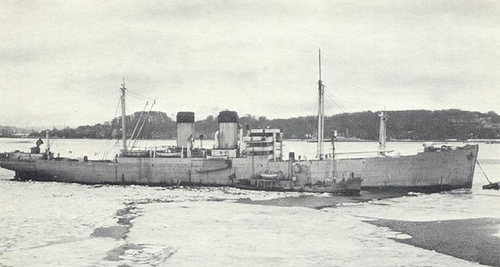 |
| The Orion, “Schiff 16” to the Germans and codenamed “Raider A” by the British. |
The Luftwaffe attempts a raid for a second night in a row on the Bristol docks and nearby factories. For one reason or another, five of the six bombers abort the mission, but one Heinkel He 111 of III/KG55 makes it through to bomb the Bristol Aeroplane Company at Filton.
The Luftwaffe lays mines off Whitby. One of the Heinkel 111s has to ditch, and the crew is later rescued by the British after a full day adrift.
The RAF sends a raid against Merville and loses 3 of 9 Blenheims from RAF No. 107 Squadron. It also attacks Vignacourt, north of Abbeville. Targets in western Germany include oil storage tanks at Hamburg and an aerodrome at Norderney.
The fighters assigned to the Kriegsmarine aircraft carrier Graf Zeppelin, Tragergruppe 186, are re-assigned to JG 77 in defense of Berlin.
Battle of Britain: Luftwaffe boss Hermann Goering prepares the Luftwaffe for the upcoming Battle of Britain, stating that the mission is:
...to attack the enemy air force by day and night, in the air and on the ground, without consideration of other tasks.Goering assigns three Luftflotten to the task of overcoming the RAF: Luftflotte 2 will operate from France, Luftflotte 3 from the Low Countries, and Luftflotte 5 from Stavanger airfield in Norway.
North Africa: The Regia Aeronautica bombs the 1st King's African Rifles unit at Moyale, Kenya.
War Crimes: The RAF shoots down a Heinkel He 59 which is clearly marked with white-painted, Red Cross emblems. The aircraft is engaged in a search and rescue mission and is not a legitimate target. This incident causes the Luftwaffe to camouflage and arm their search and rescue planes.
German Military: The Wehrmacht has been unstoppable to date, and everyone believes that the fall of Great Britain is now only a matter of (very little) time. However, Major General Alfred Jodl of the OKW proposes two alternative modes of attack:
- A direct invasion of Great Britain;
- A peripheral strategy of isolating England by overcoming its forces in the Mediterranean and elsewhere.
US Navy: The US Navy continues its "show the flag" operation in Latin America. Heavy cruiser USS Wichita arrives at Montevideo, Uruguay, joining cruiser USS Quincy. The intention is to combat growing pro-German sentiment in certain circles there.
An inventory taken on this day, halfway through 1940, shows that the US Navy has 1,099 ships, with 160,997 in the Navy, 38,364 in the Marine Corps, and 13,766 in the Coast Guard, for a total of 203,127.
Prisoners of War: The SS Arandora Star departs from Great Britain for Canada carrying 1200 German and Italian POWs. Many of them are simply civilians being interned.
China: At the Battle of South Kwangsi, the Japanese 22nd Army approaches Lungchin.
The British evacuate their women and children from Hong Kong.
Holocaust: Himmler suggests removing the entire existing Polish population - to where or how is not decided - and replacing it with German "settlers."
Polish Homefront: The Polish Government-in-exile places General Rowecki in command of the Polish underground.
French Homefront: The Chantiers de Jeunesse, a quasi-military youth organization somewhat reminiscent of the Hitler Youth, is formed.
German Homefront: Listening to the BBC is strictly forbidden anywhere in Germany or occupied Europe. Today, five such "radio criminals" are sentenced to five years in concentration camps. However, the BBC is widely viewed as more factual than the German propaganda broadcasts, so almost everyone tunes in at least occasionally.
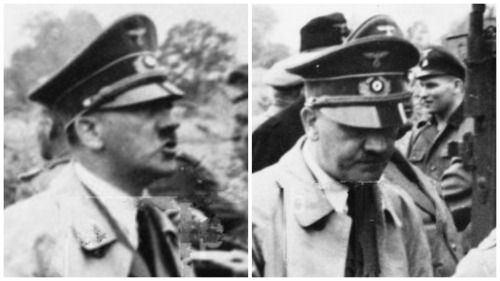 |
| Hitler in unguarded moments on 30 June 1940. |
June 1, 1940: Devastation at Dunkirk
June 2, 1940: Hitler Visits France
June 3, 1940: Operation Paula
June 4, 1940: We Shall Fight
June 5, 1940: Fall Rot
June 6, 1940: Weygand Line Crumbling
June 7, 1940: British Evacuating Narvik
June 8, 1940: Operation Juno
June 9, 1940: Norway Capitulates
June 10, 1940: Mussolini Throws Down
June 11, 1940: Paris an Open City
June 12, 1940: Rommel at St. Valery
June 13, 1940: France Goes Alone
June 14, 1940: Paris Falls
June 15, 1940: Soviets Scoop Up Lithuania
June 16, 1940: Enter Pétain
June 17, 1940: The Lancastria Sinks
June 18, 1940: A Day of Leaders
June 19, 1940: U-boats Run Wild
June 20, 1940: Pétain Wilts
June 21, 1940: Hitler's Happiest Day
June 22, 1940: France Is Done
June 23, 1940: Hitler in Paris
June 24, 1940: Six Million Jews
June 25, 1940: German Celebrations
June 26, 1940: USSR Being Belligerent
June 27, 1940: Malta in Peril
June 28, 1940: Channel Islands Bombed
June 29, 1940: Gandhi Insists on Independence
June 30, 1940: Channel Islands Occupied
July 1940
July 1, 1940: Vichy France
July 2, 1940: Arandora Star
July 3, 1940: Operation Catapult at Mers El Kébir
July 4, 1940: Romania In Crisis
July 5, 1940: The Five Freedoms
July 6, 1940: Hitler's High Point
July 7 1940: Dakar And Ringo
July 8, 1940: Tea Rationing in England
July 9, 1940: Battle of Calabria
July 10, 1940: Battle of Britain Begins
July 11, 1940: "Nous, Philippe Petain"
July 12, 1940: Enter Laval
July 13, 1940: German Surface Raiders Attack!
July 14, 1940: Bastille/Mourning Day
July 15, 1940: Tallest Man Dies
July 16, 1940: Plans for Sea Lion
July 17, 1940: Burma Road Closed
July 18, 1940: FDR Runs Again
July 19, 1940: Last Appeal To Reason
July 20, 1940: First Night Fighter Victory
July 21, 1940: Soviets Absorb Baltic States
July 22, 1940: First RAF Night Fighter Victory
July 23, 1940: Invasion False Alarm
July 24, 1940: The Meknés Incident
July 25, 1940: Black Thursday for RAF
July 26, 1940: Capture The Duke?
July 27, 1940: What's Up, Doc?
July 28, 1940: Destroyers Pulled From Dover
July 29, 1940: Barbarossa On The Burner
July 30, 1940: Hitler Delays Sealion
July 31, 1940: Bloody Wednesday of Olkusz
2020









